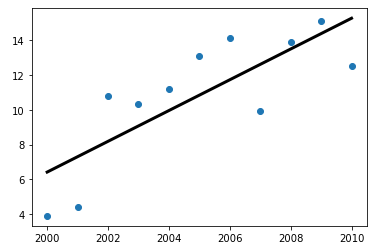除1.132节介绍的的线性回归系数可用来计算线性回归外,sklearn库中也有相关的函数用来计算一元线性回归,同时还可以输出回归线,为数据可视化提供了便利。
1 | from sklearn.linear_model import LinearRegression |
参数:
fit_intercept :是否计算截距,若数据已中心化,则可以不计算。默认True。
normalize :若开启,则对数据进行归一化处理。
copy_X :若开启,则复制X,否则对X进行重写覆盖。
属性:
coef_ :线性回归系数
intercept_ : 截距
方法:
fit(x,y) :建立x,y的回归模型
predict(x) :利用回归模型进行预测
score(x, y[, sample_weight]) :返回R^2
1 | from sklearn.linear_model import LinearRegression |

该方法较1.132节相对繁琐,甚至有些小题大做。因为该方法主要用于通过已有数据建立回归模型,对未知数据进行一元回归预测,在机器学习中使用更为广泛,在此处,仅仅体现了较为方便的回归线的绘制。